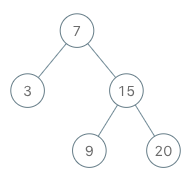实现一个二叉搜索树迭代器类BSTIterator ,表示一个按中序遍历二叉搜索树(BST)的迭代器:
BSTIterator(TreeNode root) 初始化 BSTIterator 类的一个对象。BST 的根节点 root 会作为构造函数的一部分给出。指针应初始化为一个不存在于 BST 中的数字,且该数字小于 BST 中的任何元素。
boolean hasNext() 如果向指针右侧遍历存在数字,则返回 true ;否则返回 false 。
int next()将指针向右移动,然后返回指针处的数字。
注意,指针初始化为一个不存在于 BST 中的数字,所以对 next() 的首次调用将返回 BST 中的最小元素。
可以假设 next() 调用总是有效的,也就是说,当调用 next() 时,BST 的中序遍历中至少存在一个下一个数字。
示例:
输入
inputs = [“BSTIterator”, “next”, “next”, “hasNext”, “next”, “hasNext”, “next”, “hasNext”, “next”, “hasNext”]
inputs = [[[7, 3, 15, null, null, 9, 20]], [], [], [], [], [], [], [], [], []]
输出
[null, 3, 7, true, 9, true, 15, true, 20, false]
解释
BSTIterator bSTIterator = new BSTIterator([7, 3, 15, null, null, 9, 20]);
bSTIterator.next(); // 返回 3
bSTIterator.next(); // 返回 7
bSTIterator.hasNext(); // 返回 True
bSTIterator.next(); // 返回 9
bSTIterator.hasNext(); // 返回 True
bSTIterator.next(); // 返回 15
bSTIterator.hasNext(); // 返回 True
bSTIterator.next(); // 返回 20
bSTIterator.hasNext(); // 返回 False
提示:
树中节点的数目在范围 [1, 105] 内
0 <= Node.val <= 106
最多调用 105 次 hasNext 和 next 操作
进阶:
你可以设计一个满足下述条件的解决方案吗?next() 和 hasNext() 操作均摊时间复杂度为 O(1) ,并使用 O(h) 内存。其中 h 是树的高度。
暴力
class BSTIterator {int index = 0;Map<Integer,Integer> map = new HashMap<>();public BSTIterator(TreeNode root) {Deque<TreeNode> stack = new LinkedList<>();while (root != null || !stack.isEmpty()) {if (root != null) {stack.push(root);root = root.left;} else {TreeNode node = stack.poll();map.put(++index,node.val);root = node.right;}}}int idx = 0;public int next() {return map.get(++idx);}public boolean hasNext() {if (idx < index) return true;return false;}}
/**本题采用类似单调栈的做法,因为BFS是有序的 所以我们中序遍历时当遇到栈顶节点有右子树时,就将该节点的右子树和右子树的左子树全加入栈中,形成了单调栈的结构初始我们只需将树的所有子节点加入栈中*/Deque<TreeNode> stack = new ArrayDeque<>();public BSTIterator(TreeNode root) {while (root != null) {stack.push(root);root = root.left;}}public int next() {TreeNode node = stack.poll();if (node.right != null) {TreeNode cur = node.right;while (cur != null) {stack.push(cur);cur = cur.left;}}return node.val;}public boolean hasNext() {return !stack.isEmpty();}

